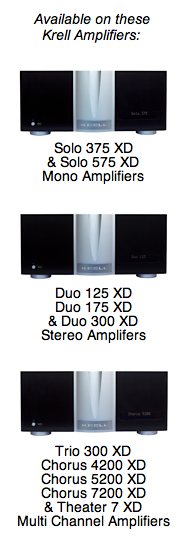Krell's Class A iBias™ Technology

Krell’s history is rich with breakthrough Class A amplifiers that have helped build the Krell legacy of offering the best sounding amplifiers available. Audiophiles have always considered Class A technology to be the best sounding operating state for amplifiers. However, despite Class A’s unrivaled sound quality, it has fallen out of fashion because of recent demands to reduce power consumption and heat in home electronics products. Krell engineering took this challenge and redefined the meaning of high performance power amplifier. Our goal: unmatched performance, elegant design, and a compelling array of features.

Krell’s Major Technological Breakthrough—a patent pending circuit delivering Class A operation without the excessive heat and wasted energy of conventional designs, housed in a striking new form factor, with network connectivity for advanced access and monitoring.
The sound is open and unconstrained, in a manner that rivals live performance and the true sound of voices and instruments. Music and dialogue are reproduced with a richness, detail, and startling dynamics that fill a room.
Plainly stated, Class A designs are the most musically accurate circuit topology available. Class A amplifiers do not suffer from the inherent distortions that all Class AB amplifiers experience. In a traditional Class A design, the output transistors conduct full current at all times regardless of the actual demand from the speakers. Often, only a fraction of this power is needed to reproduce an audio signal at normal listening levels. The rest of the power is dissipated through the amplifier’s heat sinks, producing large amounts of wasted heat. With Krell’s iBias™ technology, bias is dynamically adjusted, so the output transistors receive exactly as much power—but only as much power—as they need.
Krell’s iBias Class A technology allows our latest amplifiers to run in full Class A mode to full power while minimizing heat generation. Previous efforts at using a “tracking” bias, while effective, only measured the incoming signal and set bias levels from this information. Our new patent pending iBias technology significantly elevates the effectiveness of previous designs by calculating bias from the output stage. This seemingly small change in topology results in a dramatic improvement in sound quality, especially midrange richness and purity.
The core of the technology is an innovative, patent pending design for a dynamic intelligent bias circuit. Our iBias Class A circuit directly measures the output current of the amplifier and adjusts the bias to the optimum level. Because iBias Class A measures the output current, the real time demands of the specific speaker connected to the amp are directly incorporated into the circuit function. In addition, iBias Class A even reduces the bias when the signal is at very low levels, making its operation undetectable by ear and even by standard amplifier measurements.
In sliding bias schemes, the circuit merely estimates how much bias is needed based on the input signal and an “assumed speaker load.” Compared with iBias Class A, these sliding bias technologies are much less effective—and much less accurate.
Krell’s New XD™ Technology
XD is a classic example of Krell’s continuous R&D efforts, reaping benefits across multiple product lines. During the development of the K-300i Integrated Amplifier we discovered substantial sonic improvements lowering the output impedance below traditional norms. When applying this technique to our existing line of amplifiers, the improvement was so substantial, it deserved its own, unique designation—XD.
It was no simple matter merely lowering the output impedance. This affects the amplifier’s stability and transient response, so each stage prior to the output stage had to be re-tuned to work optimally with the lower output impedance. This lower output impedance exerts more control over the speaker drivers, and damps out unwanted vibrational modes—allowing a more accurate reproduction of the original signal.




